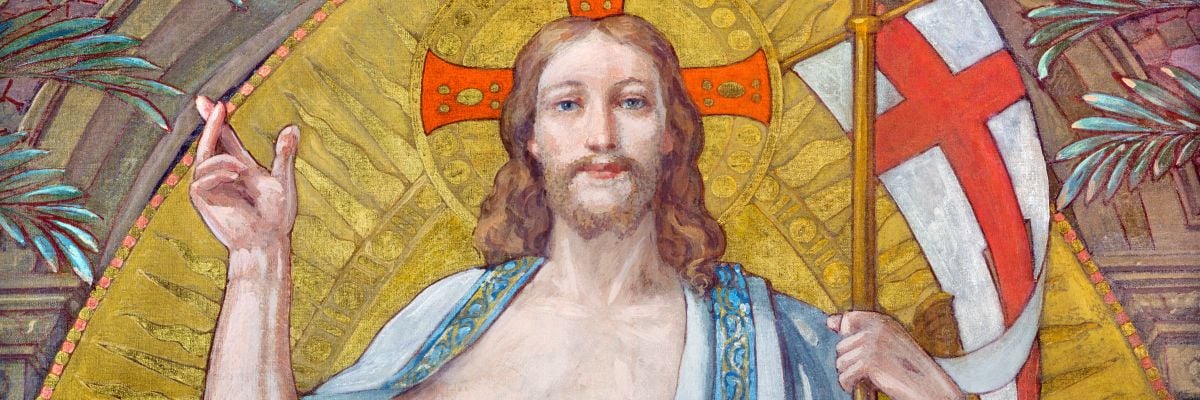
Most Christians say the apostles came to believe Jesus was God after seeing how Christ’s resurrection vindicated his claims to divinity. But Bart Ehrman’s book, How Jesus Became God: The Exaltation of a Jewish Preacher from Galilee, offers another theory.
Ehrman is popular New Testament textual critic who was once a Fundamentalist Christian and is now an agnostic. Ehrman’s big claim to fame came with his 2005 book Misquoting Jesus, where he argued that the text of the New Testament was corrupted through the scribal copying process. He then argued that this corruption jeopardizes our orthodox understanding of the Bible. The book has sold millions of copies, and you’ve no doubt seen or heard Ehrman on late-night television, including the Colbert Report.
Ehrman’s thesis is that the divide between human and divine in the ancient world was not as clean cut and “uncrossable” as it is for modern religious believers. According to Ehrman, in the ancient world it was common for the divide to be crossed in either the “gods come down in the likeness of men” direction or the “men go up and become gods” direction. Within this cultural milieu it was not improbable for the apostles to believe that their good rabbi had become “God.”
I enjoyed the book, and I think it’s disappointing how many Christians jump into an automatic “pan-the-heretic” mode before reading it. Don’t misunderstand me: I think Ehrman is wrong, but his book is well-written.
Gods and men in the Ancient World
The first two chapters describe the malleable barrier between gods and men. The first few pages left a sour taste in my mouth. Ehrman begins with a story about a first-century miracle worker whose disciples believed he was the Son of God and had survived his own death. But, surprise! Ehrman’s not talking about Jesus but another supposed miracle-worker and contemporary of Jesus named Apollonius of Tyana. This sets the stage for Ehrman to talk about how in the ancient world men who become gods and vice-versa were really a dime a dozen.
However, Ehrman neglects to mention that although we have multiple sources for the life of Jesus we only have one source for Apollonius. Ehrman says this source, Philostratus, recorded what eyewitnesses said about Apollonius, but neglects to mention that the only eyewitness mentioned is one Damis from Nineveh, a city that didn’t even exist in the first century (which means Damis probably did not exist either). Ehrman also doesn’t mention how the wife of emperor Severus commissioned Philostratus to write the biography of Apollonius over a century after Apollonius’s “death.” The Life of Apollonius was probably created as a competitor to the Gospel accounts of Jesus which, by that point, were in wide circulation across the Roman Empire.
Ehrman acknowledges this theory in a footnote but then claims that all he is doing is showing how belief in “God-men” was easily accepted in the Roman cultural context; but I find this answer unsatisfying. If belief in a God-man like Apollonius was only easily accepted because it was crafted to imitate Jesus, it still doesn’t explain how Jesus’ divinity came about.
Perhaps the most striking concession Ehrman makes in this section is that Apollonius is the only story of a true “God-man” like Jesus. Ehrman writes, “I don’t know of any other cases in ancient Greek or Roman thought of this kind of “God-man,” where an already existing divine being is said to be born of a mortal woman.” If the story of Apollonius is parasitic upon the story of Jesus, then that makes the story of the “God-man” Jesus all the more exceptional and difficult to explain without recourse to a miracle.
The Resurrection of Jesus
In chapter three we get a crash course in “historical Jesus studies” or the use of objective criteria to find what the nineteenth-century Biblical critic Martin Kähler called “The Jesus of History” (as opposed to the supposedly non-historical “Christ of faith” who inhabits the catechism). At about this point I noticed that some of what Ehrman was discussing also popped up in his previous book, Did Jesus Exist?
I think it was New Testament critic Burton Mack who said that the greatest mystery of Christianity is the question of how Jesus came to be worshipped as God so quickly after his death. Mythicists who deny Jesus existed have a simple answer: he was always worshipped as God and the human part was added later. Ehrman rejects that view, but has to find a way to get Jesus up the “ontological totem pole” at a very fast rate. Ehrman claims to be able to do this in his analysis of the Resurrection, an “event” that he says was necessary for Jesus not to be remembered as just another failed messiah.
Ehrman is adamant that this was not a fluffy “resurrection of Easter faith,” nor was it a “spiritual resurrection” as other critics try to make it out to be. It was instead a real bodily resurrection that the apostles proclaimed. He is careful to say, however, that it was belief in the resurrection that caused the apostles to think Jesus was God, and not the resurrection itself. Ehrman then devotes two chapters to providing a natural explanation for how this belief in the resurrection came about.
His main point is that although he once believed that we could know Joseph of Arimathea buried Jesus, he has now changed his mind and says we can’t know that for sure. He says we simply can’t know what happened to the body of Jesus. We can know, however, that the apostles had visions of Jesus after his death, but that was probably because they were bereaved and such visions are actually quite common. He says the answer to the question of whether or not these visions were real or hallucinatory is beyond the reach of the historian.
My Thoughts on the Resurrection
I’m not convinced by Ehrman’s arguments against the authenticity of the burial tradition. Hesays that because Joseph and the empty tomb are not mentioned in the creed in 1 Corinthians 15:3-5, this shows it was probably a legendary development. But the creed’s use of the word buried (in Greek, hetaphe) implies something formal and ceremonial, not a mere chucking of a body into a ditch. In addition, there’s no reason to include those details in 1 Corinthians because they were not needed. When the creed says “Christ appeared” it’s natural to ask “to whom did he appear?” The creed answers this question with a list of witnesses. When it says Christ was buried, we don’t need to know who buried him, just as we don’t need to know who killed Christ (something the creed in 1 Corinthians also doesn’t mention).
In regards to the visions, how do we know that the disciples would have been bereaved and not angry that Jesus turned out to be a fraud instead of the messiah? I’m sure the disciples of John the Baptist mourned his death and may have felt guilty for not aiding him during his imprisonment, buttheir grief did not lead them to proclaim he had risen from the dead.
Overall, Ehrman’s treatment of the resurrection is good when he goes in depth about a subject and poor when he gives an off-hand response to an objection. For example, his cursory write-off of the resurrection accounts being contradictory and therefore not being reliable is not compelling because the accounts only differ in secondary details. Many ancient histories do the same. For example, among Tacitus, Suetonius, and Cassius Dio we have three different accounts of where Nero was when Rome burned, but that doesn’t mean Nero wasn’t in the city when it happened.
The Path to Orthodoxy
In chapters eight and nine Ehrman narrates the struggles within the early Church as Christians sought to lay out in specific detail what they believed about God and Jesus. If you ever take the time to read the canons from councils like Nicea and Chalcedon, then you see how it’s really difficult to describe orthodoxy correctly. It’s really easy, however, to make your view a heresy. What is the Trinity? Are the Father, Son, and Holy Spirit each gods? Nope! That’s tri-theism. Are the Father, Son and Holy Spirit each a part of God? Nope! That’s modalism. While Ehrman’s description of the early Christological controversies is fairly useful, there are parts where I think he oversimplified to the point of error.
One of those would be his assertion that the third-century popes endorsed the heresy of modalism, which claims that there is one God who is one person and that this person appears in different “modes” or roles. In this view of God, there is no relationship between the Father and the Son since they are the same person (God) just as my role as “husband” has no personal relationship as “son.” Ehrman says that Pope Callistus I (218-223) endorsed this view, but our only source for this charge is Hippolytus, who, Ehrman neglects to tell his readers, was a bitter opponent of Callistus—making his charges unreliable. Callistus was certainly no modalist because he excommunicated Sabellius, one of modalism’s primary proponents (another name for modalism is Sabellianism). J.N.D. Kelly’s Oxford reference book on the popes gives a good description of the matter here.
Closing Thoughts
There’s a lot more to discuss here (especially Ehrman’s view of Paul’s Christology), but overall I think Ehrman’s work represents the typical “Jesus was a failed end-times prophet” approach that is popular within historical Jesus studies. Ehrman does part ways with some of his like-minded colleagues, such as Dale Allison (see page 185 of How Jesus Became God), and at those points it’s nice to see Ehrman put forward a compelling argument instead of just lobbing an assertion.
For readers who want a fuller treatment of the arguments in opposition to Ehrman’s case, I’d recommend the following resources:
How God Became Jesus: The Real Origins of Belief in Jesus’ Divine Nature—A Response to Bart Ehrman. As the tile suggests, this book represents the viewpoints of five authors who disagree with Ehrman’s thesis. Kind of a mixed bag when it comes to quality, but Craig Evans’s essay on Jesus’ burial is worth the whole price.
Jesus and the Eyewitnesses: The Gospels as Eyewitness Testimony. This book by Richard Bauckham is a must-read for anyone who glosses over Ehrman’s claim that the Gospels were not written by eyewitnesses and so cannot be trusted.
The Resurrection of the Son of God. The well-known New Testament scholar N.T. Wright gives one of the most comprehensive treatments of both the resurrection and the surrounding cultural context that makes a natural “legend-based” explanation of the resurrection very implausible.



